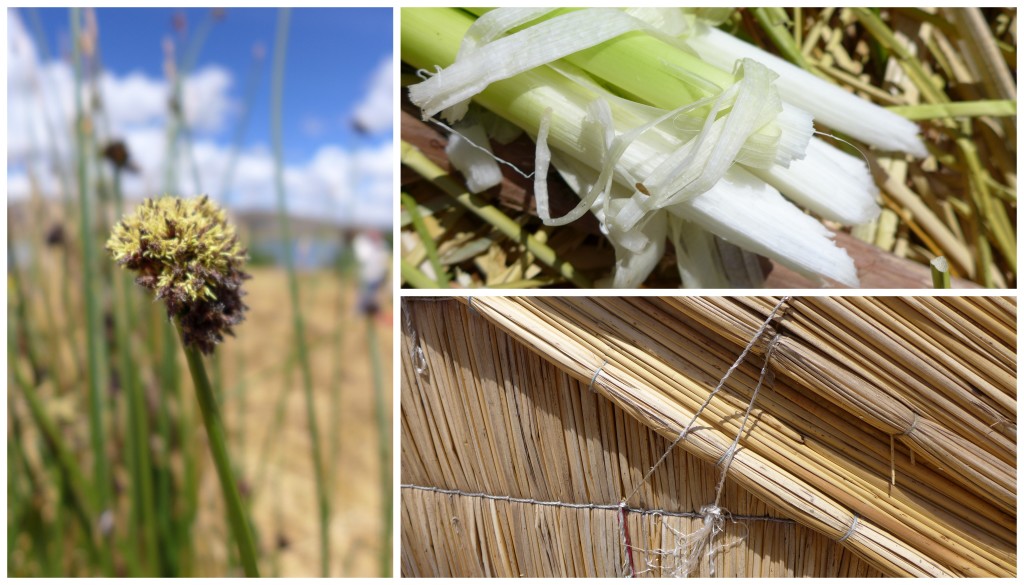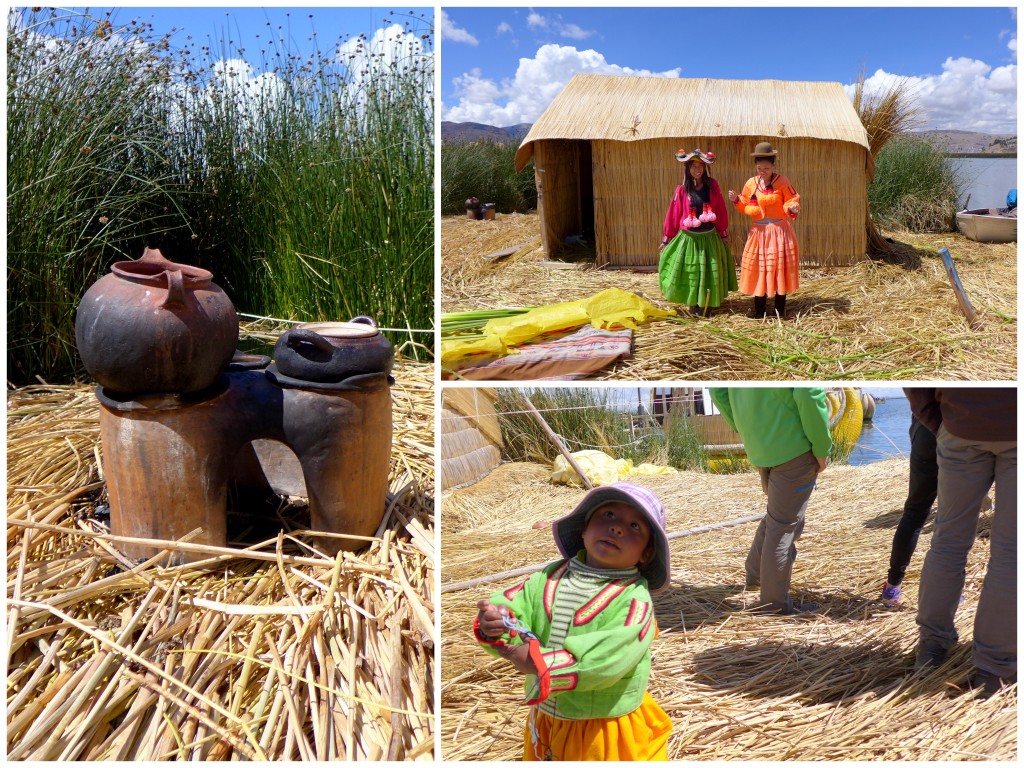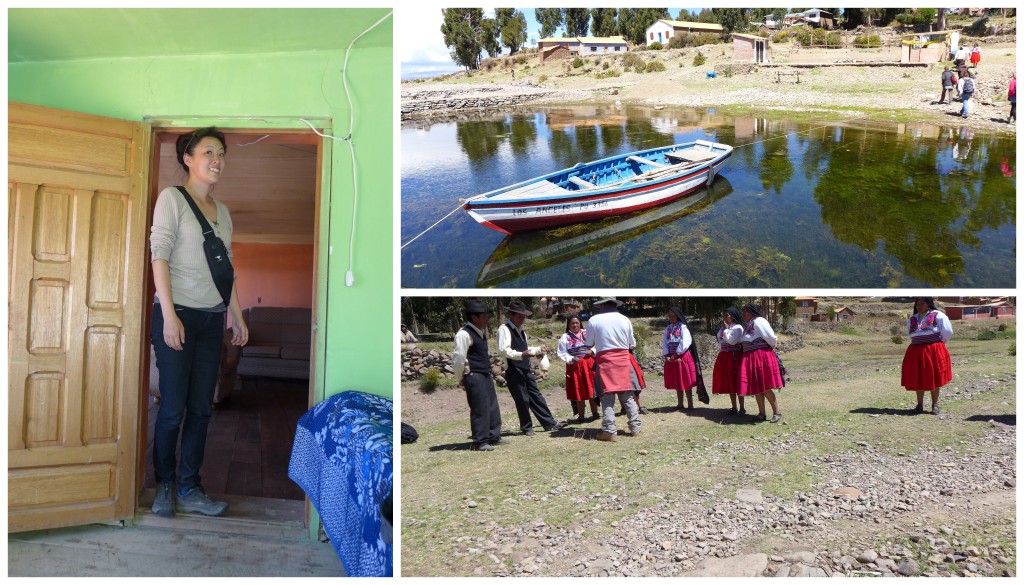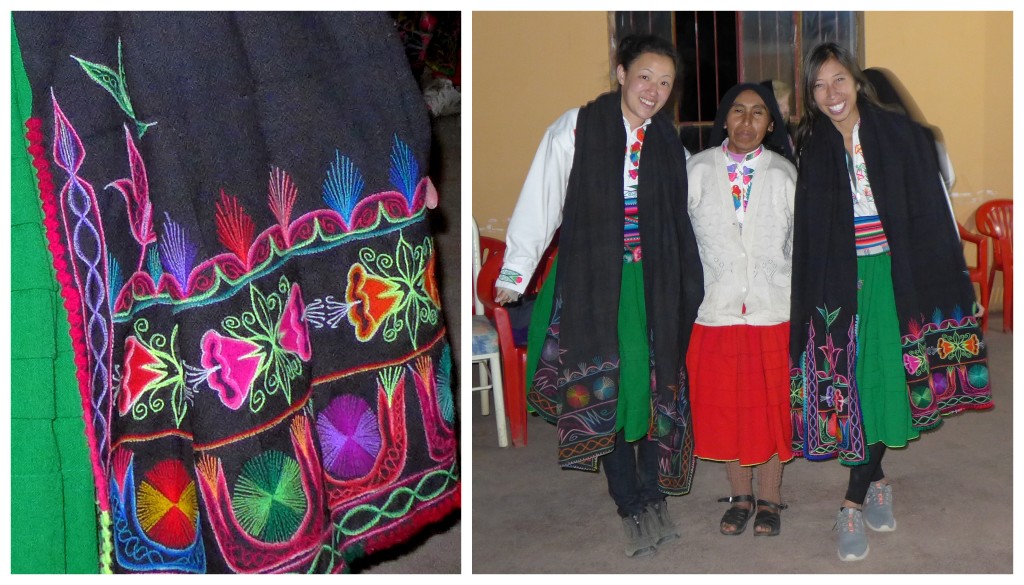Floating Islands on Lake Titikaka
Most often seen spelling is Titicaca but while we were there, the locals spelled it as Titikaka, so that’s what I’ll go with.
The Uros, pre-Inca people who live on forty-two self-fashioned floating islands in Lake Titicaca Puno, Peru and Bolivia.
In the morning we were picked up by the tour van for a two days one night trip on Lake Titikaka. The van brought us to the port and allowed 10 minutes to shop for any gifts we want to bring to our family stay on the Amantani island. Annie brought sweets and snacks and I bought some snacks and some pellet pencils.
From the port we got on the boat that will take us to the Uros islands and then Amantani. The Uros are an indigenous group who building their lives on Lake Titikaka. They use totora reeds to build the houses, boats, and other infrastructures. The islands themselves are layers of “khali” the people gather from the depth of the lake and anchored to sticks driven into the bottom of the lake.
According to our guide, there were still approximately 80 islands (communities) inhabited by the natives. Tourism, handicrafts and fisheries are their main source of income.However, the up and coming generation of Uros are mostly educated in the city of Puno and many, post graduation, chose to stay in the city. The guide predicts that in a few decades, the islands may be purely memorial, maintained for the purpose of tourism.
Totora Reeds
The most important element to the Uros’ lives are the totora reeds. Cut and peeled, they can chew the white roots for iodine and it also serves as a form of dental floss. Sliced in half, they can use the roots to stay cool by placing it on their foreheads. They also use the totora flowers to brew tea which has similar effects as coca leafs.
Off the corner of her eyes, Annie saw another group swapping outfits and trying on some traditional Uros clothes. She jumped on that right away. It’s only a week post halloween after all! The traditional clothings are bright with a heavy multi-layered skirt, topped with a hat too small for any heads.
After this island/community, we went and visited a larger island with fisheries, restaurants, and shopping booths. A bit of rest later we hopped back on the motor boat to head towards the Amantani island where we will meet our host family and stay the night.
It was a slow (maybe 25 mph?) and sunny ride. In between fresh air and comfort, I had to interchange seats in the boat and out on the deck constantly. Sometimes the captain will close his eyes for a few minutes, but at our rate against the vast blue lake, it would be a miracle for him to hit something. Three hours later we arrived on the Amantani island where we were greeted by the cutest little ladies (and two gentlemen) and their welcome song “Vamos a la playa!”
We got paired up with our host, Olga, and followed her to her home. She doesn’t speak English so we tried to get by with the little Spanish we know. We learned that her husband works in Puno and has three kids, oldest is 18 and youngest 7, all of them are in school, away from home. At the house with her was her father and they have 3-4 guestrooms on the second level of their home. Olga also doesn’t like many animals except for sheep. She has about 10 sheep in the backyard.
In the afternoon, Olga took us to the main square to meet up with the tour group for a hike to the mountain top for a view of the sunset. I opted out of it, still tired from Machu Picchu, and stayed at a coffee shop in the main square while Annie went with the group. A really terribly bitter cup of instant coffee later, I got invited to join a group of teacher and drink some “pisco tea.” NOW we’re talking! Always drink the local stuff, anything western are pretty crappy. Pisco tea was like their version of eggnog or gluhwein. Made of tea, lemon juice and pisco, it was perfect for the high altitude evening chills that always come immediately after the sun sets.
Teachers on the island, taught me pisco tea.
With pisco warmth in me to brave the cold and Olga who was waiting for us to go back for dinner, Annie and I said goodbye to the teachers and asked if they would like to join the [very touristy] dance party later.
At Olga’s, she made a tasty homestyle dinner though a bit on the starchy side. Don’t think I ever had potatoes on rice! And after one meal, I’m already used to having a cup (or three) fresh munay tea to keep up with the digestions.
With dinner all said and done, Olga brought out two sets of her own traditional outfits for us to wear. They were handsewn by her PAPA. The details and colors were amazing, it’s hard to imagine it came from the callus covered fingertips of a man. Yet it showed so much patience and tenderness from whom would otherwise be described as “solid as a rock.”
The dance party started off like a casual prom night (minus the much needed bowl of punch). We all sat in our seats not knowing what to do with ourselves. Then the band tried to pump up the party with a local pop song and suddenly we’re in an Amanati version of the chu chu train; giant circles of people hand in hand filled the room.
We were graced by a surprise visit from our new friends, the group of teachers from the cafe earlier. They said the locals don’t usually attend these since it’s very much geared towards tourists so we were happy that they made an exception! Though the fun was short lived because our day began at 7 AM and the dance party didn’t start till 9 PM. I was barely shuffling my feet at this point, and would like to shuffle it towards a bed and not in a circle…
Guest appearance from new drinking buddies earlier.
Day 2 on Amantani Island
In the morning we woke up to a hot meal Olga prepared for us and we gave her our thank you gifts. She seemed especially delighted with the pencils, I’m guessing because most of the time the ship brings in food and necessities instead.
Olga walked with us to the pier where we bid farewell and off to the next island for trekking. Along the lake were other islands of various sizes and each had the staircase fields built back in the Inca era, that can still be used today, if one was willing to put in the effort to renovate. An hour and a half later, we arrived at the dock and took another hour to hike up to the center of town. From the hillside, the water was in all shades of blue and had mini waves as if we were by the seaside.
On this island, traditions were followed as it were hundreds of years ago, and the elders are adamant to keep it that way. The women was wearing the traditional outfits of the embroidered peacoat, head sarong, and puffy skirts, while the men wore the white shirts with black pants and an embroidered hat. The teenagers (the hardest group to tame in any culture) are required to wear traditional clothing while they are on the island, and many changes to modern clothing on their way to Puno and back.
While the island seemed to function as if their culture and traditions are intact, the shift in mentally was inevitable. After I took the picture of the little boy above, he held out his hand, presumably at the expectation of money. I was a bit shocked but good thing I came prepared. I had pencils with me and I gave him one, and asked if he was in school. Same thing happened after Annie took pictures of these sheep in the middle of a path. The old shepherdess held out her hand and whined for money. I tried to give her pencils as well, but she refused to take it. I don’t have any change, I said. She mumbled a few sentences as we sped up our strides in the other direction.
Please, when you’re a tourist, stop giving out money!!!
It screws up the whole balance of human interactions and converts it into transactions. Feel sympathetic? Bring something useful or meaningful with you instead. Erasers, pens/pencils, sweets, or books even, if you can carry it. Free money never saved anyone, instead it encourages lust, laziness and entitlement.
When we got to the top, there was a textile building in the center of a square where you can buy handicrafts made by the men of the village.
An expensive (but really good) lunch on a terrace with the view of the hills, we continued to trek to the other side of the island, where the boat was waiting. It’s very nice to go through a town and not worry about vehicles at all because the paths had steps and no vehicles were allowed. The last stretch was a set of steps. 582 steps to be exact. The guide said it with such confidence but when ANnie asked, did you count it yourself? Did you count the small half steps? The guide was once again pointed out, by her, for not being ‘completely honest’.
Last Night in Puno
Annie had two things on her agenda when we got back to Puno. One – find “Cuy,” the guinea pig dish, and two – find peruvian chicken (or just chicken since we’re in Peru….). And I had only one – get our passport photos taken.
We walked about the city center and finally found a passport shop. You get 4 small and one large portrait for $2 USD. The man/photographer brought us up the stairs to a makeshift attic that was barely over five feet high. There was a couple of pans of water with a bit of grease floating on the surface, a few mirrors, and a peeling white wall. We “got ready” for our “photo shoot” and the guy took our pictures with his fancy Nikon D300 DSLR. He then loaded the picture into Photoshop on the computer. He asked what background we wanted and if we want to be in a different outfit with accessories. We should have gone all out with this but — it was for border crossing so maybe we shouldn’t push it.
Passport photos, check. We were then on the hunt for the two dinners. Tripadvisor advised us to a very good local restaurant, Casa Grill La Estancia, for cuy. Since we had to save room for the chicken, we only ordered one guinea pig and nothing else. To wait for this dish was not helping Annie feel more comfortable. She was recounting her pet gerbil and rabbit, then all of a sudden, we see the golden screaming guinea pig on a platter on the table. It really does look like a rat without tail!
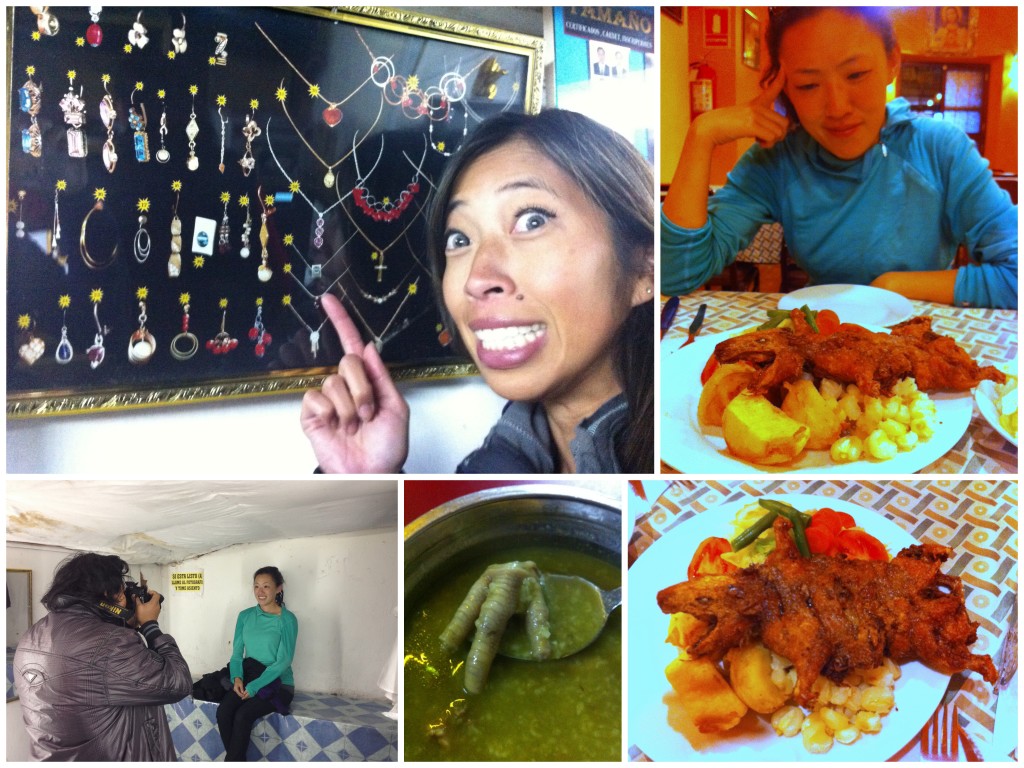
Add your own jewelry for the passport. Creepy photo shoot room. Cuy. and the unexpected chicken feet!
How’d it taste? For me it was quite good, a bit like pork/duck. For Annie, the more she tried, the more she thought about her gerbil. So I ate the rest of her portion happily because it was such a skinny guinea pig.
We then went two blocks down for a roasted chicken restaurant. We ordered just one portion and it came with soup, more than plenty after the first dinner. I really enjoyed the soup until the discovery of a familiar dimsum dish — chicken feet. Yuck/yum?? Such weird dinners in one night. Oh Peruvianos, good thing we are Asians.
Cost highlight:
- Tour to the islands, 2D/1N: $60 USD


